16 Games, Dec. 15/17/18/19, 2022
+ 1 A2pt. +2/232\
Week 15: 83 touchdowns, 8 ATDs + 1 A2pt.
MIA@BUF: Two points . . . for this?
How can this be? Quarterback takes a snap; attempts a freeform forward dive over his offensive line; in midflight loses his grip on the ball; watches it get booted and batted 25 yards upfield — and is eventually informed the entire fiasco has earned his team two points. Sure, just how coach wrote it up.
Listed in the Bills’ playbook as Catastrophe Over Left Tackle (just our guess), few plays make a more convincing case for abandoning the break-the-plane rule than this garish mishmash. This is the most technical of technical scores. For a blink of time, airborne Josh Allen unknowingly pokes a fragment of football into the end zone’s airspace. A half-blink later, the ball is slipping from his hands.
Yet it is all ruled worthy of two points, which ties the game and perhaps adds to Buffalo’s momentum. The Bills eventually win 32-29 on a last-second field goal.
An instant classic? Not this play. Hocus Bogus rating: 5
Video and first image: NFL Network
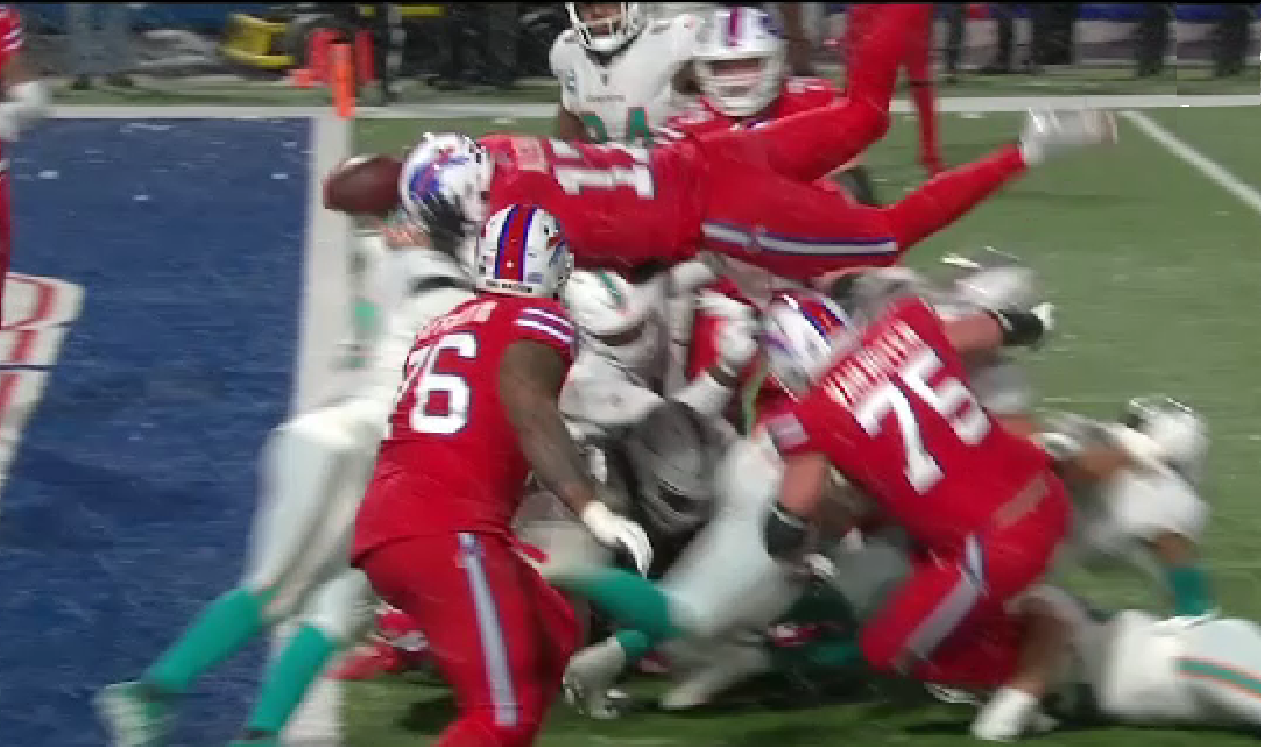
The ball is slipping from Josh Allen’s grip, but a split-second earlier it nicked the plane — a fragment of time judged to be worth two points.
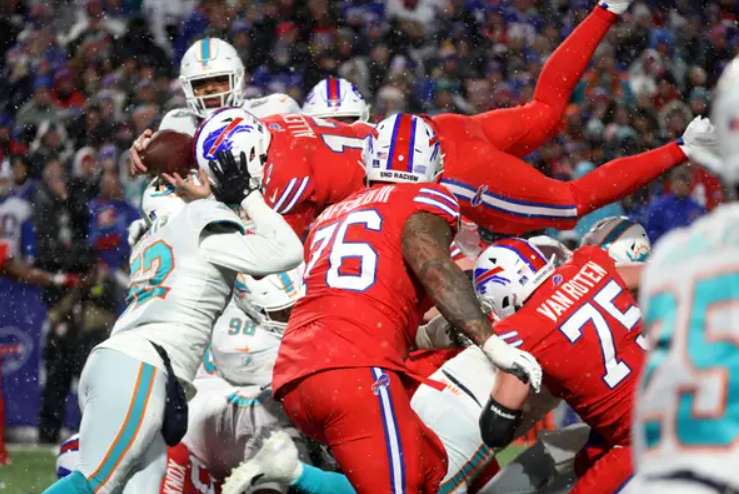
Miami LB Elandon Roberts (52) hits Allen, jars the ball loose and keeps Allen out of the end zone. Good play, but no glory. Image by Jamie Germano
KC@HOU: Reach out and touch nothing
This strikes us as unfair to the defense. Houston LB Christian Harris (48) and lineman Roy Lopez (91) seal off the end zone as KC’s Patrick Mahomes scrambles left. But the break-the-plane rule allows Mahomes to run out of bounds yet still get credit for a touchdown because he waved the ball over the end zone’s airspace.
This has the effect of widening the area that tacklers need to defend. Had Mahomes been required to turn upfield and physically contact the end zone — the core concept of our proposed rule — he would have faced a greater challenge and might have been stopped short. It would have been a far more interesting play to watch than this can’t-catch-me pylon wave-over — a cheap, corner-cutting (literally) shortcut to six points.
We say it often: Let’s put the touch in touchdown. Rating: 5
Video and images: CBS Sports
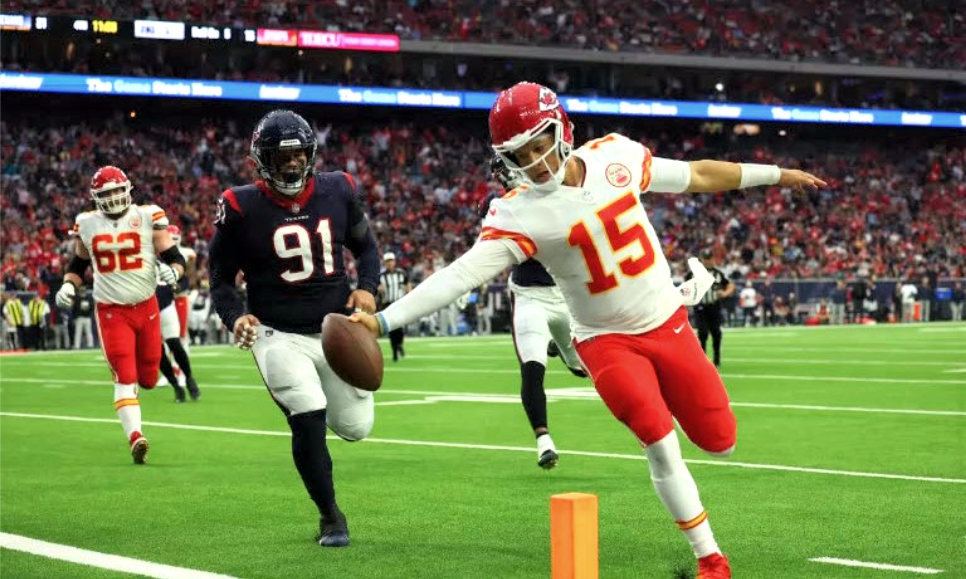
It’s easier to avoid tacklers when you can run wide of the end zone.
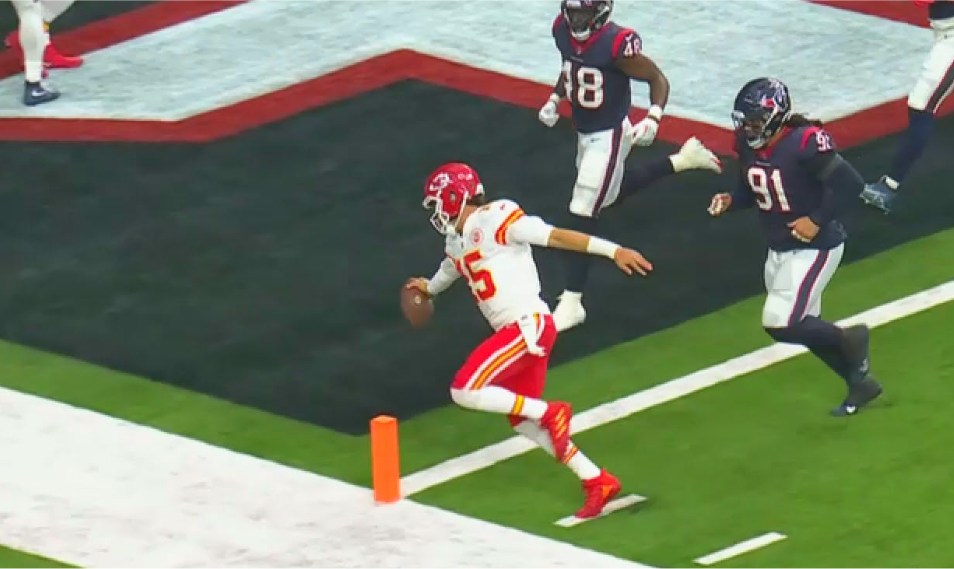
Defense does its job, closing off the end zone. So Mahomes just avoids it.
IND@MIN: No touch, no touchdown
Our rule, if enacted, will change a lot of close-call rulings that, based on the existing break-the-plane interpretation, seem innocuous and generally acceptable. This particular week featured a slew of calls that would be judged differently. So is our rule going too far? We say no. It’s just setting a higher bar that will, over time, be accepted as the new norm.
In our rule, we argue a ball carrier must make some contact with the end zone, however minimal. It can be a finger, a toe, whatever. But it has to be something.
Here Minnesota’s Cortez Ham plows into the line and his forward progress stalls as he comes to rest atop a stack of bodies on the goal line. He is ruled to have broken the plane, even though he has not touched the end zone, and is awarded a touchdown. Sorry. We say the defense did its job and kept the runner out of the scoring area. Make it second-and-goal from the 1-inch line. Rating: 2
Video and images: NFL Network
PHI@CHI: Mosh pit x2
Twice in the same game (in the same half, no less) Philadelphia’s Jalen Hurts comes to a stop atop a pile of linemen, above the end zone, but not on the end zone surface — paydirt, as it was once called. No matter. Using break-the-plane (BTP) reasoning, both pushes are good for touchdowns.
If, as we advocate, neither result would be worthy of a touchdown, coaches would be forced to design a play more interesting to watch than these almost static push-and-pause yawners.
Where’s the excitement in this? We don’t see it, and we wish we didn’t have to watch it any more. Rating: 2
Video and images: Fox Sports
AZ@DEN: Breaks the plane, yes, but . . .
Denver’s Latavius Murray makes an excellent effort to try and reach the ball into the end zone, and using the break-the-plane interpretation, this qualifies as a touchdown. We just don’t think it should be, because Murray lands on his back without his arm or the ball first making contact with the end zone.
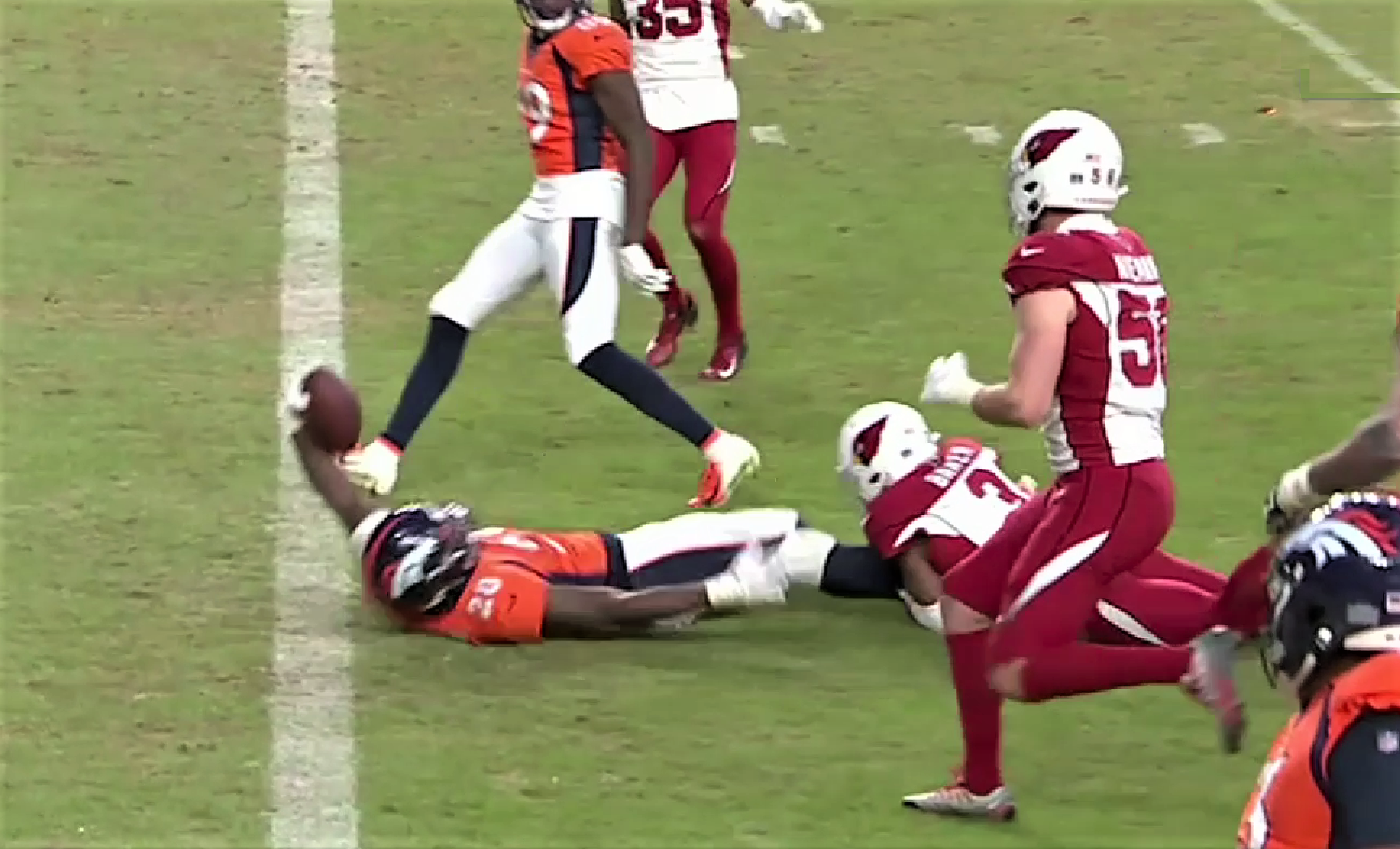
Are we being fussy about where and when the ball and player reach the end zone? Yes, yes we are. That’s the higher standard we think football, a physical game to its core, should adopt: Reach the physical end zone, not just its airspace, to earn a touchdown. Rating: 1.5
Video and image: Fox Sports
KC@HOU: Spot of first contact matters
Our rule demands a higher standard for earning a score. Whizzing through the end zone’s airspace does not cut it; a player must contact some part of the end zone. And a player’s first contact with the end zone must be fully in-bounds. Due to that judgment, we would not award KC’s Jerick McKinnon a touchdown here.
McKinnon floats over the far corner of the end zone, close to the pylon, and when his left foot makes first contact with the end zone, it is barely, fractionally, almost imperceptibly out of bounds.
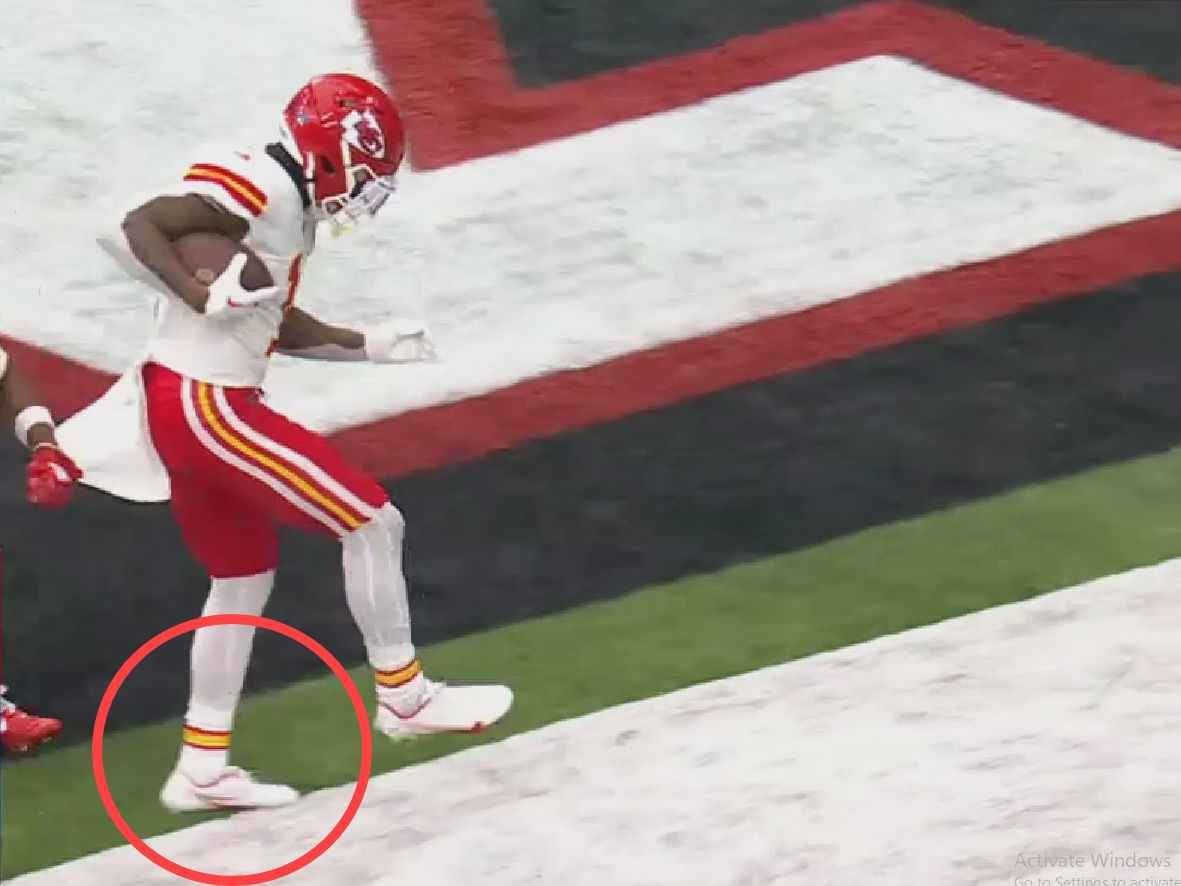
But out of bounds it is. So we would give Kansas City the ball inside the 1, first-and-goal. This seems like splitting hairs, but if our rule was in place, a defensive coordinator would rightly challenge this call. The defense prevented McKinnon from making full in-bounds contact, so line up again and earn your TD. Rating: 1
Video and image: CBS Sports
ATL@NO: Knee down, so no touchdown
‘The Saints Juwan Johnson makes a truly valiant, athletic stretch for the goal but, in our view, his right knee and thigh contact the ground just moments before the ball in his right hand, gripping the ball, hits the goal line.
This is really close, and we can understand how New Orleans fans would gripe about our ruling. But if we’re going to banish the ugliest of the break-the-plane touchdowns, a play such as this would have to be ruled short of the goal. First-and-goal inside the 1. Rating: 1
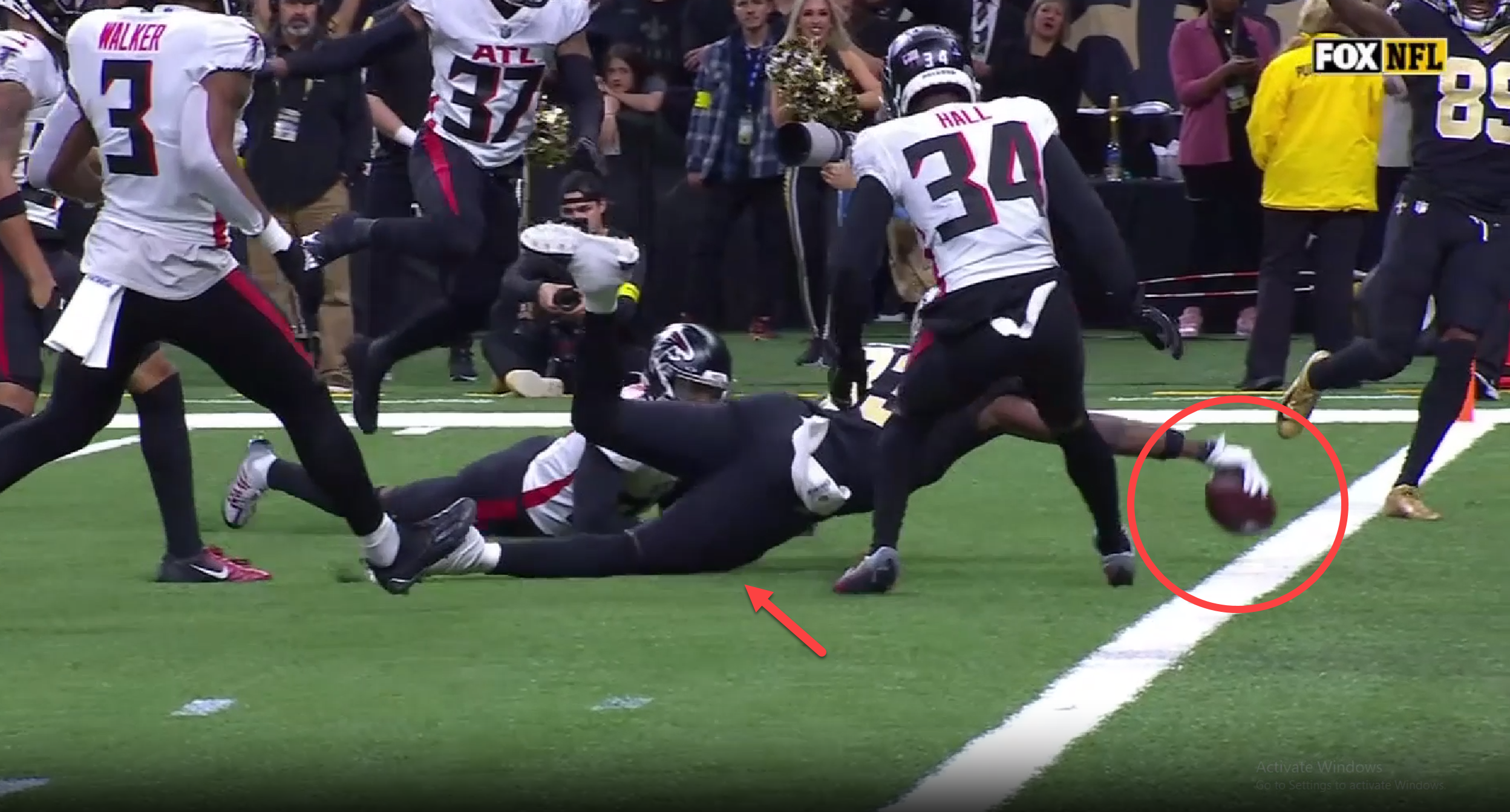
Video and image: Fox Sports (edit by ESPN)
DAL@JAX: A close, really close call
Using break-the-plane rationale, yes, this is a touchdown. But we want to toss out that reasoning. Here Ezekiel Elliott’s right shoulder contacts the ground just before his ball-carrying right arm hits the end zone. Thus, in our view, Dallas would get the ball inside the one. Line up for another play.
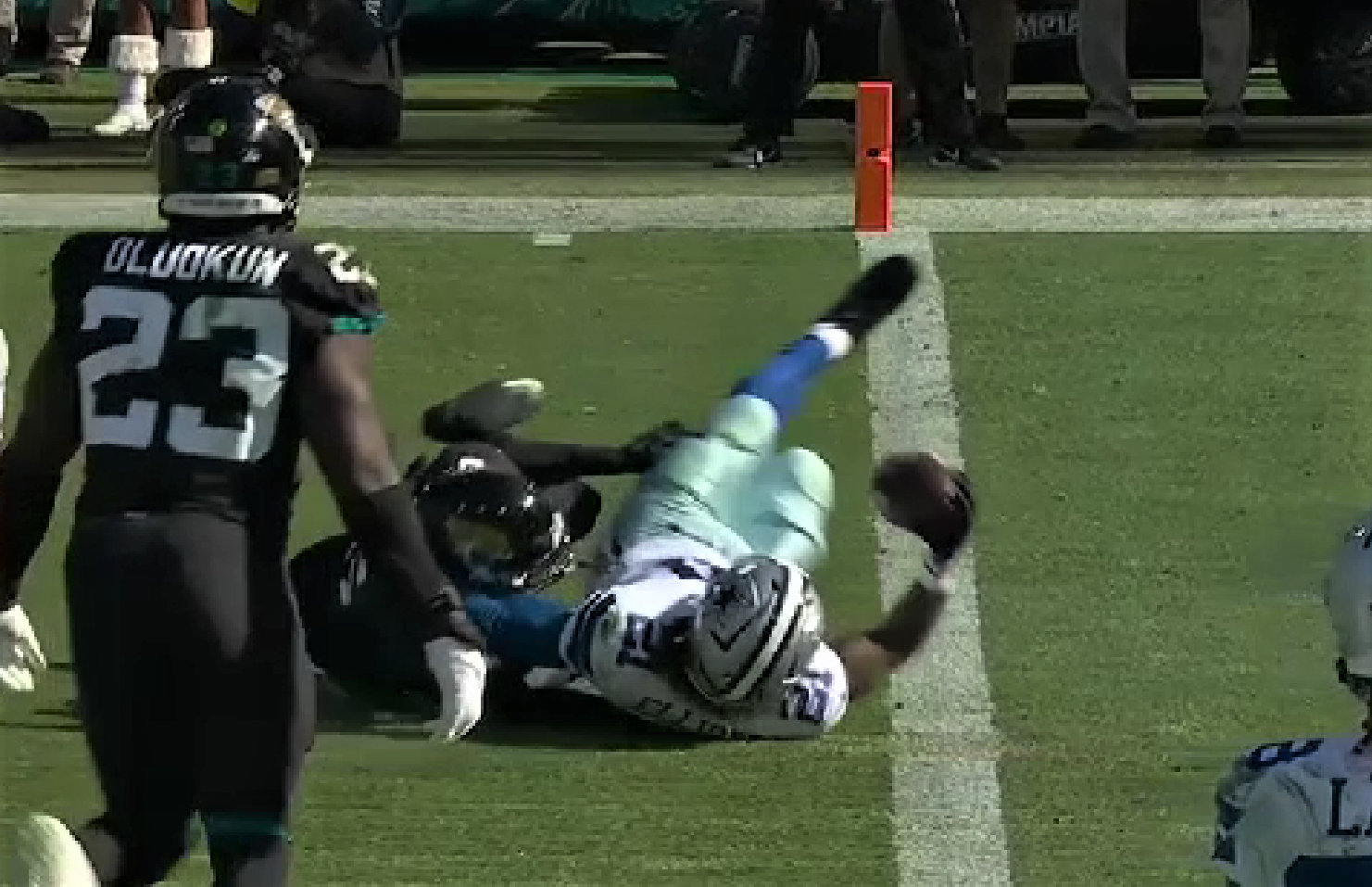
We recognize this is really close. But we’re aiming for a higher standard on such plays. First down contact must occur on or beyond the goal line. If not, no TD.
If we call a play an airspace touchdown, it’s because it does not meet the new criteria for a touchdown that we would like to see. Aim high, and we believe fans will be treated to more satisfying, no-doubt touchdowns. Rating: 1
Video and image: Fox Sports
